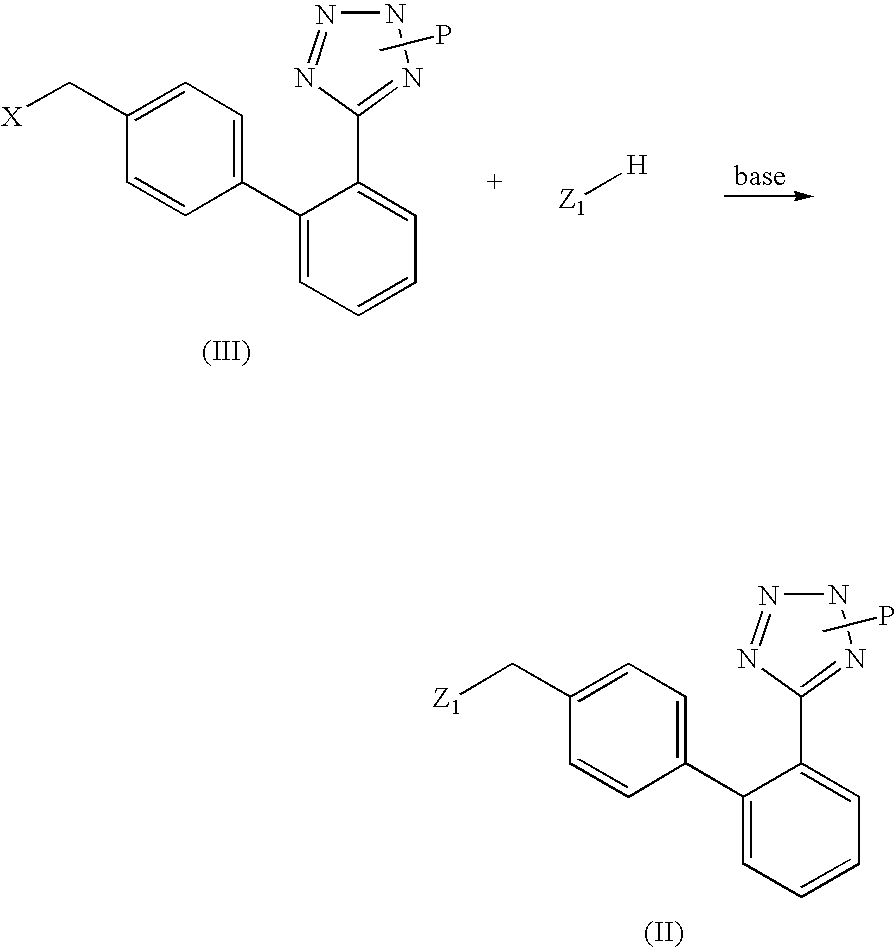Phenyltetrazole compounds
a technology of phenyltetrazolium and compounds, applied in the field of substitution of phenyltetrazolium compounds, can solve the problems of remarkably difficult use of thiols and derivatives thereof, and the requirements of industrial production of the reagents used
- Summary
- Abstract
- Description
- Claims
- Application Information
AI Technical Summary
Problems solved by technology
Method used
Image
Examples
example 1
Preparation of (2-butyl-5-chloro-3-{2′-[2-(1-methyl-1-phenyl-ethyl)-2H-tetrazol-5-yl]-biphenyl-4-ylmethyl}-3H-imidazol-4-yl)-methanol; [(VI), Z is 2-butyl-4-chloro-5-hydroxymethyl-imidazol-1-yl; P is 1-methyl-1-phenylethyl (cumyl)]
[0034] A suspension of [2′-(1-methyl-1-phenyl-ethyl)]-2H-tetrazol-5-yl]phenyl boronic acid (26.7 mmoles, 8.3 g) in diethoxymethane is added under stirring with two portions of water (0.55 ml, 31 mmoles) at room temperature, in about 1 hour. After completion of the addition, potassium carbonate (8.6 g, 62 mmoles), [3-(4-bromo-benzyl)-2-butyl-5-chloro-3H-imidazol-4-yl]-methanol (8.97 g, 25 mmoles), triphenylphosphine (262 mg, 1.0 mmoles), palladium acetate (56 mg, 0.25 mmoles) and THF (20 ml) are added. The mixture is refluxed for 6 hours, then the aqueous phase is discarded. The organic phase is washed with 30 ml of water, concentrated to dryness and the resulting product is crystallized from isopropanol, thereby obtaining 10.6 g of (2-butyl-5-chloro-3-{2′...
example 2
Removal of the Protecting Group from a Compound (VI)
[0042] 10 g (0.02 moles) of (2-butyl-5-chloro-3-{2′-[2-(1-methyl-1-phenyl-ethyl)-2H-tetrazol-5-yl]-biphenyl-4-ylmethyl}-3H-imidazol-4-yl)-methanol are dissolved in 50 ml of 37% aqueous hydrochloric acid under stirring at a temperature of 15-20° C. The mixture is stirred for a further 4h, then washed 3 times with 25 ml of toluene. The aqueous phase is poured into a solution of 55 g of sodium acetate in water, the formed precipitate is filtered, thoroughly washed with water and dried under vacuum at 70° C., thereby obtaining 8 g of losartan.
[0043] NMR: 1H (DMSO, 300 mHz): δ0.80 (3H, t, J=10, CH3), 1.25 (2H, sest, J=10, CH3CH2), 1.45 (2H, quin, J=10, CH3CH2CH2), 2.45-2.55 (2H, m, CH3CH2CH2CH2), 4.30 (2H, 2H, CH2OH), 5.30 (2H, s, CH2Ar), 7.10 (4H, s, ArH), 7.45-7.70 (4H, m, ArH).
[0044] Operating analogously, from the respective intermediates of formula (VI) obtainable according to Example 1, the following compounds: valsartan, irbes...
example 3
Removal of the Protecting Group from a Compound (VI)
[0045] 10 g (0.02 moles) of (2-butyl-5-chloro-3-{2′-[2-(1-methyl-1-phenyl-ethyl)-2H-tetrazol-5-yl]-biphenyl-4-ylmethyl}-3H-imidazol-4-yl)-methanol are dissolved in 50 ml of dichloromethane and gaseous HCl is bubbled at a temperature of 0-10° C. After 2h the reaction mixture is poured into a solution of 55 g of sodium acetate in water, the formed precipitate is filtered, thoroughly washed with water and dried under vacuum at 70° C., thereby obtaining 7.8 g of losartan.
[0046] Operating analogously, from the respective intermediates of formula (VI) obtainable according to Example 1, the following compounds: valsartan, irbesartan, candesartan and olmesartan can be obtained.
PUM
| Property | Measurement | Unit |
|---|---|---|
| Fraction | aaaaa | aaaaa |
| Fraction | aaaaa | aaaaa |
| Fraction | aaaaa | aaaaa |
Abstract
Description
Claims
Application Information
 Login to View More
Login to View More - R&D
- Intellectual Property
- Life Sciences
- Materials
- Tech Scout
- Unparalleled Data Quality
- Higher Quality Content
- 60% Fewer Hallucinations
Browse by: Latest US Patents, China's latest patents, Technical Efficacy Thesaurus, Application Domain, Technology Topic, Popular Technical Reports.
© 2025 PatSnap. All rights reserved.Legal|Privacy policy|Modern Slavery Act Transparency Statement|Sitemap|About US| Contact US: help@patsnap.com



